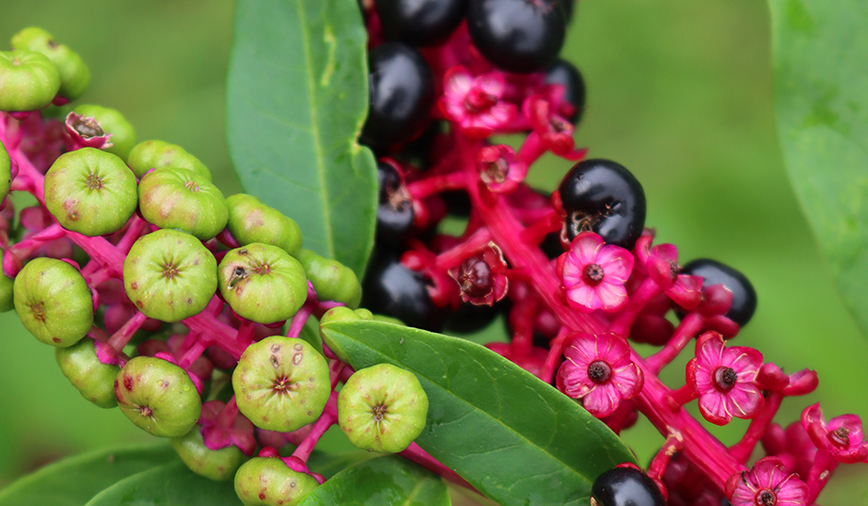It’s been said that the longest journeys start with a single step. But what I learned this week is that some journeys start with a single click.
The adventure started innocently enough, on Labor Day, with a walk to Geneva Commons to meet my friend Lisa. Along the way I ran into friends Nanette and Steve and, as nature chats often do, the talk turned to a plant that had sprouted in their backyard.
Nanette had identified it as pokeweed, Phytolacca americana. (Okay, she left out the Phytolacca part. She’s an architect, not a nature nerd.) Then she off-handedly mentioned that supposedly the ink used to pen the Declaration of Independence was derived from the deeply hued berries of the pokeweed plant, giving rise to its other common name, inkberry.
From there, Nanette and Steve steered the conversation toward other topics, like their new bookshelves and the dog. Meanwhile, though, my mind was stuck on pokeweed. “Holy cow!” I thought to myself, “That common plant may have played a major role in American history! Did Nicolas Cage mention this in ‘National Treasure?’ Where has this wonderful interpretive fact been hiding all my life? I have to check this out!”
That night, the clicking began. Computer mouse in hand, I visited several web sites that describe the pokeweed plant (alternate, light-green leaves, succulent reddish stems, elongated clusters of flowers that turn into dark purple berries); its nutritional properties (twice as much vitamin C as spinach); its medicinal uses (for treating respiratory ailments, rheumatism, arthritis, dysentery, and cancer); its toxins (oxalic acid, saponins and the alkaloid phytolaccin; and its music ties (“Poke/Polk Salad Annie” by Tony Joe White, covered by Elvis Presley).
But the only site I saw that talked about pokeweed ink being used on the Declaration of Independence was Wikipedia, the on-line “encyclopedia” of largely unaccredited facts. That article, in addition to mentioning the Declaration, also said that Civil War soldiers writing from battlefields used pokeweed ink, and that the “writing in these surviving letters appears brown.”
“Hmm,” I thought. “Wonder why the writing on the Declaration of Independence doesn’t appear brown?” I had other questions too. Where were the botanical references to pokeweed ink? The history web sites? The scientific articles?
The next night the clicking took a different approach. Using Google, my favorite search engine, I typed in the words “Declaration of Independence” and “ink.” I found other web sites that mentioned pokeweed ink being used on the Declaration, but the phrasing they used was just like that on Wikipedia, leading me to believe that these sites copied the Wikipedia work.
Finally, after more clicking, I hit pay dirt on a web site maintained by the U.S. Government’s National Archives and Records Administration. One page on the site details the history of the Declaration of Independence, including the parchment and…(drum roll)…ink! Our Declaration of Independence, the document that proclaimed the birth of our nation, was written in…
Iron gall ink.
Say wha…? I’ll spare you the details of the amount of clicking that went on after that fact was revealed. Suffice it to say, iron gall ink is made from tannins extracted from oak Aleppo galls; iron sulfate; plant gum; and water. It’s indelible and corrosive; it also seems to have been the ink of choice for documents and artwork starting around the Middle Ages until about 100 years ago.
Oak galls are something we encounter frequently on walks through our local woodlands, so I’m sure this inky piece of information won’t go to waste. And pokeweed, even if its berries weren’t declared suitable for American historical documents, is still a fascinating plant. Its luscious springtime shoots sound delicious.
Can anybody recommend a recipe for poke salad?
Pam Otto is the manager of nature programs and interpretive services for the St. Charles Park District. She can be reached at potto@stcparks.org or 630-513-4346.

